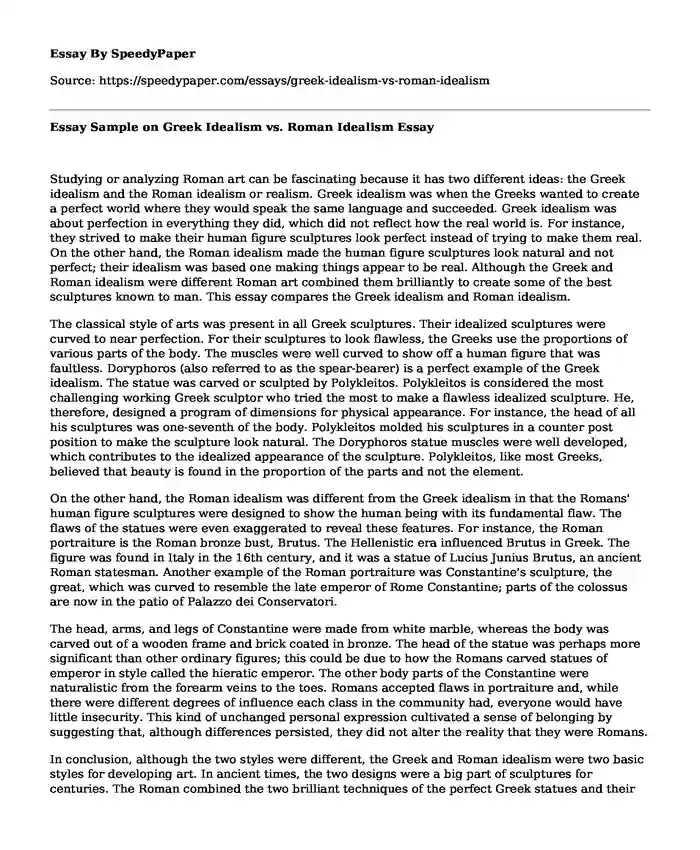
| Type of paper: | Essay |
| Categories: | History Political science Ancient Greece |
| Pages: | 3 |
| Wordcount: | 668 words |
Studying or analyzing Roman art can be fascinating because it has two different ideas: the Greek idealism and the Roman idealism or realism. Greek idealism was when the Greeks wanted to create a perfect world where they would speak the same language and succeeded. Greek idealism was about perfection in everything they did, which did not reflect how the real world is. For instance, they strived to make their human figure sculptures look perfect instead of trying to make them real. On the other hand, the Roman idealism made the human figure sculptures look natural and not perfect; their idealism was based one making things appear to be real. Although the Greek and Roman idealism were different Roman art combined them brilliantly to create some of the best sculptures known to man. This essay compares the Greek idealism and Roman idealism.
The classical style of arts was present in all Greek sculptures. Their idealized sculptures were curved to near perfection. For their sculptures to look flawless, the Greeks use the proportions of various parts of the body. The muscles were well curved to show off a human figure that was faultless. Doryphoros (also referred to as the spear-bearer) is a perfect example of the Greek idealism. The statue was carved or sculpted by Polykleitos. Polykleitos is considered the most challenging working Greek sculptor who tried the most to make a flawless idealized sculpture. He, therefore, designed a program of dimensions for physical appearance. For instance, the head of all his sculptures was one-seventh of the body. Polykleitos molded his sculptures in a counter post position to make the sculpture look natural. The Doryphoros statue muscles were well developed, which contributes to the idealized appearance of the sculpture. Polykleitos, like most Greeks, believed that beauty is found in the proportion of the parts and not the element.
On the other hand, the Roman idealism was different from the Greek idealism in that the Romans' human figure sculptures were designed to show the human being with its fundamental flaw. The flaws of the statues were even exaggerated to reveal these features. For instance, the Roman portraiture is the Roman bronze bust, Brutus. The Hellenistic era influenced Brutus in Greek. The figure was found in Italy in the 16th century, and it was a statue of Lucius Junius Brutus, an ancient Roman statesman. Another example of the Roman portraiture was Constantine's sculpture, the great, which was curved to resemble the late emperor of Rome Constantine; parts of the colossus are now in the patio of Palazzo dei Conservatori.
The head, arms, and legs of Constantine were made from white marble, whereas the body was carved out of a wooden frame and brick coated in bronze. The head of the statue was perhaps more significant than other ordinary figures; this could be due to how the Romans carved statues of emperor in style called the hieratic emperor. The other body parts of the Constantine were naturalistic from the forearm veins to the toes. Romans accepted flaws in portraiture and, while there were different degrees of influence each class in the community had, everyone would have little insecurity. This kind of unchanged personal expression cultivated a sense of belonging by suggesting that, although differences persisted, they did not alter the reality that they were Romans.
In conclusion, although the two styles were different, the Greek and Roman idealism were two basic styles for developing art. In ancient times, the two designs were a big part of sculptures for centuries. The Roman combined the two brilliant techniques of the perfect Greek statues and their statues that focused on being realistic to give heroics status to their subject.
Reference
Cooper, J. (2020). Early Roman Art - Art for all Ages. Sites.google.com. Retrieved 28 September 2020, from https://sites.google.com/site/completearthistory/art-before-the-renaissance/early-roman-art
Harris, B. (2020). Polykleitos, Doryphoros (Spear-Bearer) – Smart history. Smarthistory.org. Retrieved 28 September 2020, from https://smarthistory.org/polykleitos-doryphoros-spear-bearer
Zucker, S (2020). Doryphoros Bartleby.com. Retrieved 28 September 2020, from https://www.bartleby.com/essay/Doryphoros-F3XHWAYVC
Cite this page
Essay Sample on Greek Idealism vs. Roman Idealism. (2023, Dec 28). Retrieved from https://speedypaper.com/essays/greek-idealism-vs-roman-idealism
Request Removal
If you are the original author of this essay and no longer wish to have it published on the SpeedyPaper website, please click below to request its removal:
- Literature Evaluation Paper Sample for Free
- Theranos - Free Essay Example
- Essay Example on Neoliberalism and Anarchism
- Free Essay Example on the Zia Sun Symbol
- Essay Example on the Book The Ballot or the Bullet by Malcolm
- Essay Sample on The Relationship Between Industrialization and the Spread of Disease
- Political Temperature in China: Impact on Tesla Expansion - Essay Sample
Popular categories




